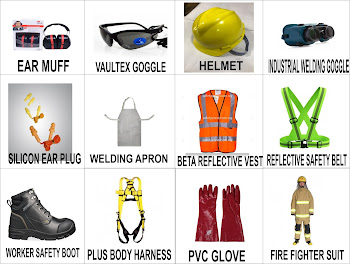HOW TO KNOW ORIGINAL SAFETY FOOTWEAR OR SAFETY BOOTS
What should I know about safety footwear?
How is footwear selected?
Footwear must be
chosen based on the hazards that are present. Assess the workplace and work
activities for:
- Materials handled or used by the worker.
- Risk of
objects falling onto or striking the feet.
- Any material
or equipment that might roll over the feet.
- Any sharp or
pointed objects that might cut the top of the feet.
- Objects that
may penetrate the bottom or side of the foot.
- Possible
exposure to corrosive or irritating substances.
- Possible
explosive atmospheres including the risk of static electrical discharges .
- Risk of
damage to sensitive electronic components or equipment due to the
discharge of static electricity.
- Risk of
coming into contact with energized conductors of low to moderate voltage
(e.g., 220 volts or less).
- Type of
walking surface and environmental conditions workers may be exposed to
(e.g., loose ground cover, smooth surfaces, temperature, wet/oily,
chemicals, etc.).
Also, evaluate the risk:
- to ankles
from uneven walking surfaces or rough terrain
- of foot
injury due to exposure to extreme hot or cold
- of slips and
falls on slippery walking surfaces
- of exposure
to water or other liquids that may penetrate the footwear causing damage
to the foot and the footwear
- of exposure
to rotating or abrasive machinery (e.g., chainsaws or grinders)
What should I
know about the fit and care of safety footwear?
Fit:
- Try
on new boots around midday. Feet normally swell during the day.
- Walk
in new footwear to ensure it is comfortable.
- Boots
should have ample toe room (toes should be about 12.5 mm from the front).
Do not expect footwear to stretch with wear.
- Make
allowances for extra socks or special arch supports when buying boots. Try
on your new boots with the supports or socks you usually wear at work.
Check with the manufacturer if adding inserts affects your level of
protection.
- Boots
should fit snugly around the heel and ankle when laced.
- Lace
up boots fully. High-cut boots provide support against ankle injury.
Care:
- Use
a protective coating to make footwear water-resistant.
- Inspect
footwear regularly for damage (e.g., cracks in soles, breaks in leather,
or exposed toe caps).
- Repair
or replace worn or defective footwear.
- Electric
shock resistance of footwear is greatly reduced by wet conditions and with
wear.
- Footwear
exposed to sole penetration or impact may not have visible signs of
damage. Replacing footwear after an event is advisable.
What symbols
will be on the footwear?
The following symbols, or markings, will help you
determine which footwear is appropriate for the job.
|
Selection
of Safety Footwear
|
||
|
Marking
|
Criteria
|
Intended
Application
|
 |
Green
triangle indicates sole puncture protection with a Grade 1 protective toecap.
|
For
heavy industrial work environments, especially that of construction where
sharp objects (such as nails) are present.
|
 |
Yellow
triangle indicates sole puncture protection with a Grade 2 protective toecap.
|
For
light industrial work environments requiring puncture protection as well as
toe protection.
|
 |
Blue
rectangle indicates a Grade 1 protective toecap with no puncture-resistant
sole.
|
For
industrial work environments not requiring puncture protection.
|
 |
Grey
rectangle indicates a Grade 2 protective toecap with no puncture-resistant
sole.
|
For
industrial and non-industrial work environments not requiring puncture
protection.
|
 |
White
rectangle with orange Greek letter omega indicates electric-shock protective
footwear.
|
For
industrial work environments where accidental contact with live electoral
conductors can occur. Warning: Electrical
shock resistance deteriorates with wear and in a wet environment.
|
 |
Yellow
rectangle with black SD letters indicates static-dissipative footwear.
|
For
industrial work environments where a static discharge can create a hazard for
workers or equipment. Warning: This
footwear should not be used where contact with live electrical conductors can
occur.
|
 |
Yellow
rectangle indicates sole puncture protection with a Grade 2 protective
toecap. (super-static dissipative footwear)
|
For
industrial work environments where a static discharge can create a hazard for
workers or equipment. Warning: This
footwear should not be used where contact with live electrical conductors can
occur.
|
 |
Red
rectangle with white C letter indicates electrically conductive footwear.
|
For
industrial work environments where low-power electrical changes can create a
hazard for workers or equipment. Warning: This
footwear should not be used where contact with live electrical conductors can
occur.
|
 |
Dark
grey rectangle with M letter indicates metatarsal protection. Note: Toe protection is required for all
metatarsal protective footwear.
|
For
industrial work environments where heavy objects can hurt the metatarsal
region of the foot.
|
 |
White
label with green fir tree symbol footwear provides protection when using
chainsaws.
|
For
forestry workers and others who work with or around hand-held chainsaws and
other cutting tools.
|
NOTE: Footwear will also be marked to indicate
the level of slip resistance. These markings may be on the packaging, the
footwear, or on a product sheet.
To buy original safety footwear or safety boots,
shoes in Nigeria, visit: Safety Zone Nigeria at www.safetyzone-ng.com or call:
07030398999
For your safety shoes, safety boots, helmet, coverall,
nose mask, safety wears and other safety equipment or products in Nigeria.
Pls visit: www.safetyzone-ng.com or call 07030398999.



Comments
Post a Comment